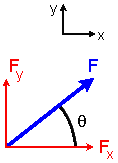Equilibrium
Once a FBD system is constructed, the next step is to apply the concepts
and conditions of equilibrium. A
body in static equilibrium is not accelerating, so the forces and moments
acting on it must sum to zero in any directions. The equations
of equilibrium require that the following conditions be satisfied:
- the sum of the forces in any direction must be zero, and
- the sum of the moments about any point in a plane must be zero.
In 3D components:
S Fx = 0 ; S Fy = 0 ; S Fz = 0
S Mx = 0 ; S My = 0 ; S Mz = 0 |
In 2-dimensions, only three equilibrium equations are required.
When the object is in the x-y plane, one of the following three
forms may be used:
S Fx = 0
S Fy = 0
S Mz = 0
|
S Fx = 0
S Mz,A = 0
S Mz,B = 0
|
S Mz,A = 0
S Mz,B = 0
S Mz,C = 0
|
| The sum of forces in x and in y, and the
sum of moments about any point (about z), equal zero |
Points A and B are two
different points. |
A, B and C are
three points, not all on the same line. |
Many problems can be reduced to 2-dimensions. |
